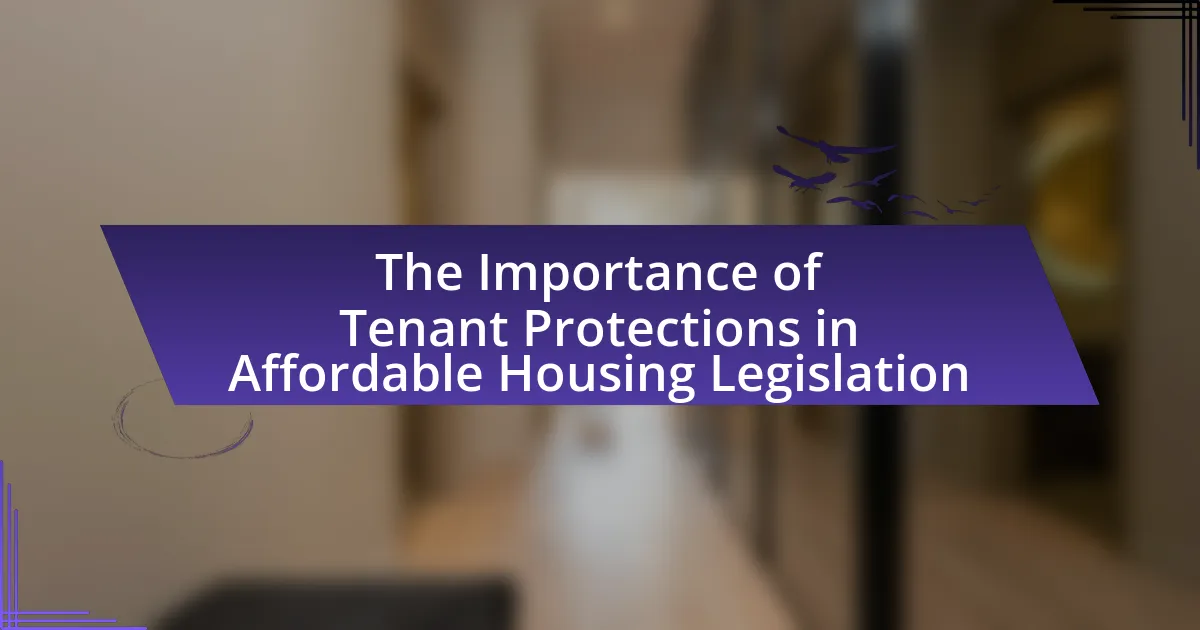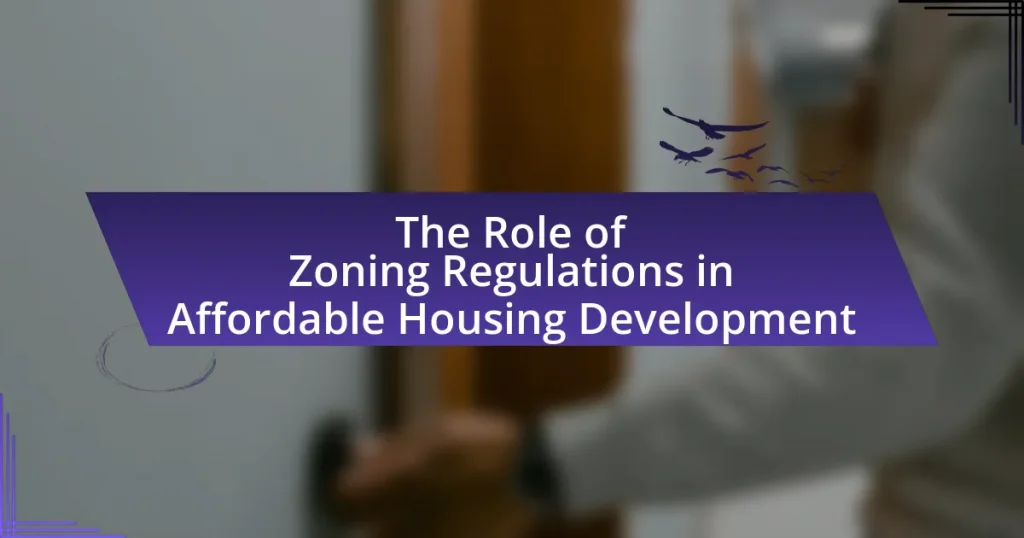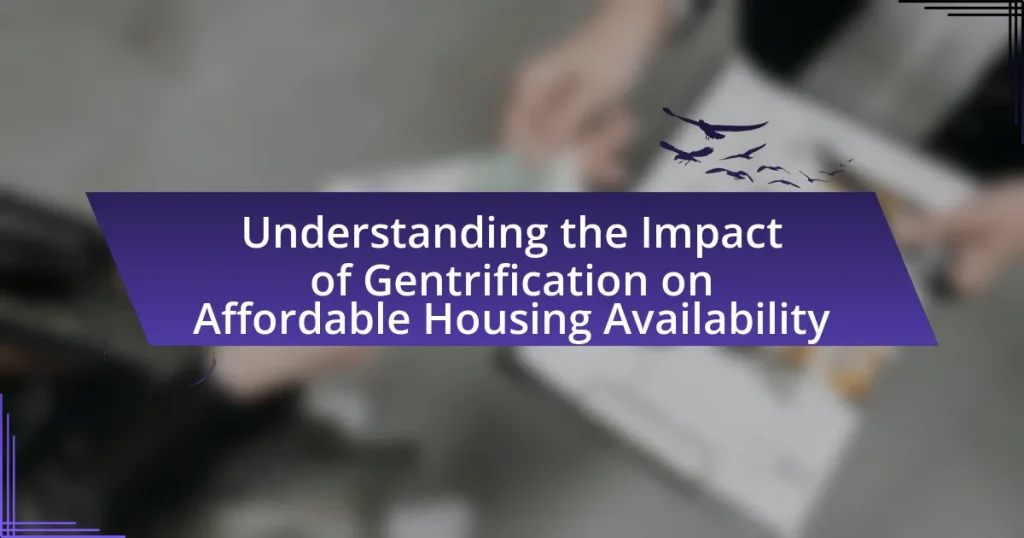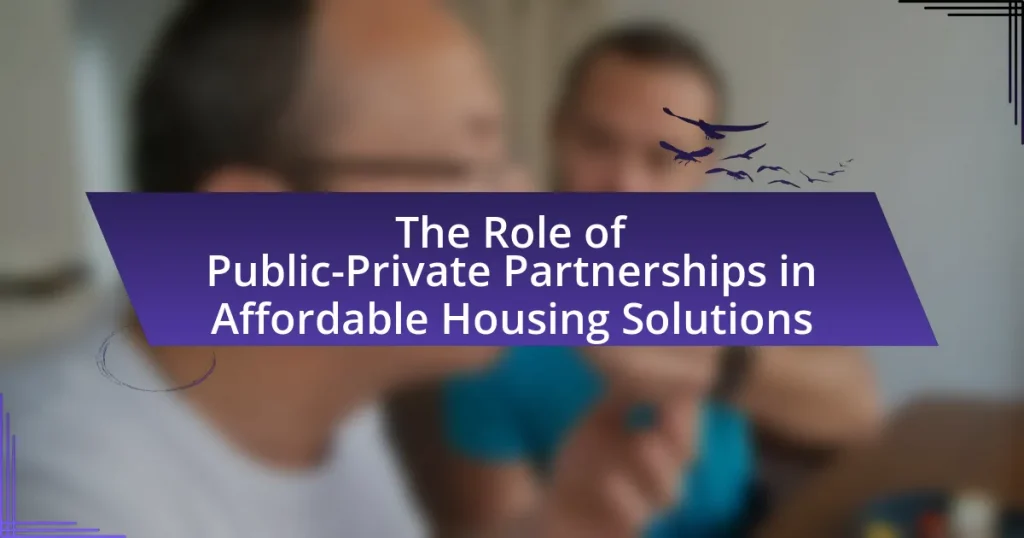Tenant protections in affordable housing legislation are essential legal measures that safeguard the rights of renters, ensuring access to safe and stable housing. This article outlines the significance of these protections, including regulations against unjust evictions, rent control policies, and requirements for landlords to maintain habitable living conditions. It discusses the specific rights provided to tenants, the impact of these protections on housing stability, and the challenges faced by tenants without such safeguards. Additionally, the article explores how tenant protections influence housing policies, the implications for landlords and developers, and innovative approaches to enhance these protections in response to housing crises. Finally, it highlights practical steps tenants can take to advocate for their rights and the resources available for assistance.
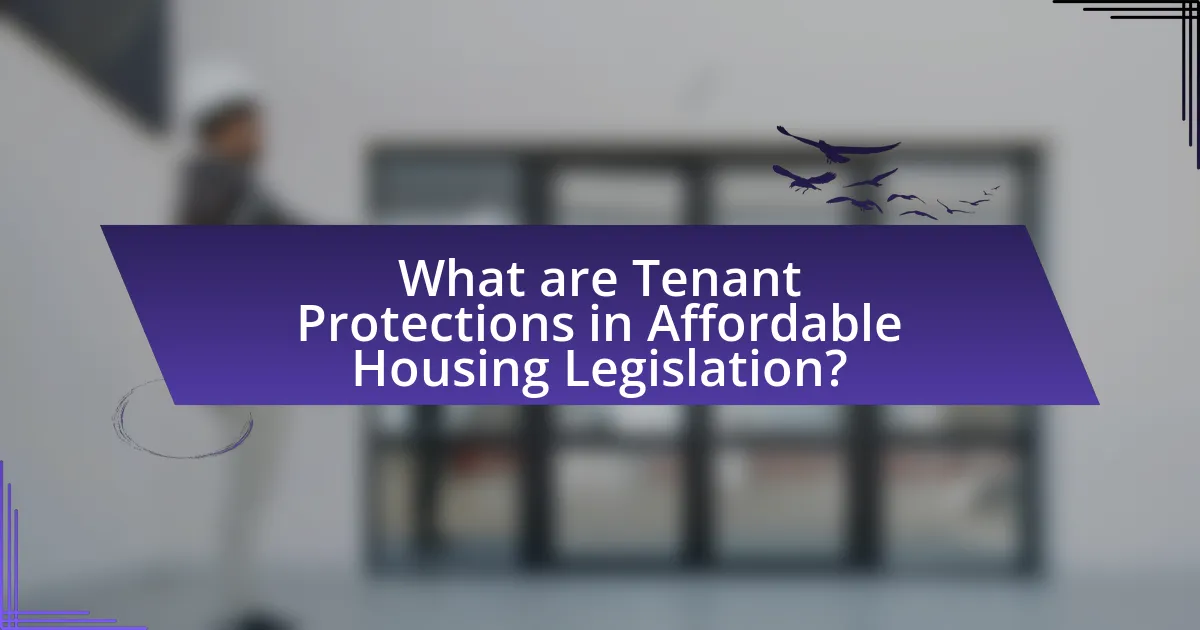
What are Tenant Protections in Affordable Housing Legislation?
Tenant protections in affordable housing legislation are legal measures designed to safeguard the rights of tenants, ensuring they have access to safe, stable, and affordable housing. These protections often include regulations against unjust evictions, rent control policies, and requirements for landlords to maintain habitable living conditions. For example, the Fair Housing Act prohibits discrimination based on race, color, national origin, religion, sex, familial status, or disability, thereby reinforcing tenant rights. Additionally, many states have enacted laws that limit the amount landlords can increase rent annually, providing financial stability for tenants. These legislative measures are crucial in preventing homelessness and promoting equitable access to housing.
Why are Tenant Protections essential in affordable housing?
Tenant protections are essential in affordable housing because they ensure stability and security for low-income renters. These protections help prevent unjust evictions, excessive rent increases, and discrimination, which can lead to homelessness and housing instability. For instance, studies show that areas with strong tenant protections experience lower rates of eviction, contributing to community stability and improved public health outcomes. Additionally, tenant protections can enhance the overall affordability of housing by limiting rent hikes, thereby allowing families to allocate resources to other essential needs.
What specific rights do tenant protections provide?
Tenant protections provide specific rights such as the right to a habitable living environment, protection against unjust eviction, and the right to privacy. These rights ensure that tenants can live in safe and secure housing without fear of arbitrary displacement. For example, laws often require landlords to maintain properties in good repair, which is a fundamental aspect of tenant rights. Additionally, many jurisdictions have regulations that limit the reasons for eviction, ensuring that tenants cannot be removed without just cause, thereby reinforcing their security in their homes.
How do tenant protections impact housing stability?
Tenant protections significantly enhance housing stability by preventing unjust evictions and ensuring affordable rent. These protections create a more secure living environment for tenants, which in turn reduces turnover rates and fosters community cohesion. For instance, a study by the Urban Institute found that areas with stronger tenant protections experienced a 20% decrease in eviction rates, contributing to greater housing stability. This stability not only benefits tenants but also supports local economies by maintaining consistent occupancy rates and reducing the costs associated with homelessness and displacement.
What challenges do tenants face without protections?
Tenants without protections face significant challenges, including the risk of eviction without cause, increased rent prices, and lack of recourse against unsafe living conditions. Without legal safeguards, landlords can terminate leases arbitrarily, leading to housing instability. According to the National Low Income Housing Coalition, nearly 70% of low-income renters experience housing insecurity, highlighting the vulnerability of tenants in unregulated environments. Additionally, the absence of protections often results in landlords neglecting maintenance and repairs, compromising tenant safety and health.
How does the lack of tenant protections affect vulnerable populations?
The lack of tenant protections significantly increases housing instability for vulnerable populations. Without legal safeguards, these individuals face higher risks of eviction, discrimination, and exploitation by landlords. For instance, studies show that low-income families, particularly those from marginalized communities, are disproportionately affected by sudden rent increases and unjust evictions, leading to homelessness or unsafe living conditions. According to the National Low Income Housing Coalition, in 2021, 7 million extremely low-income renters were severely cost-burdened, spending over half their income on housing, which highlights the urgent need for tenant protections to ensure housing security and stability for these at-risk groups.
What are the consequences of eviction without tenant protections?
Eviction without tenant protections leads to increased homelessness and housing instability. When tenants are evicted without legal safeguards, they often lack the resources to secure new housing, resulting in a rise in the number of individuals and families experiencing homelessness. According to the National Alliance to End Homelessness, eviction is a significant factor contributing to homelessness, with studies indicating that families with eviction records are more likely to face barriers in accessing future housing. Additionally, the absence of tenant protections can exacerbate economic disparities, as marginalized communities are disproportionately affected, leading to long-term social and economic consequences.
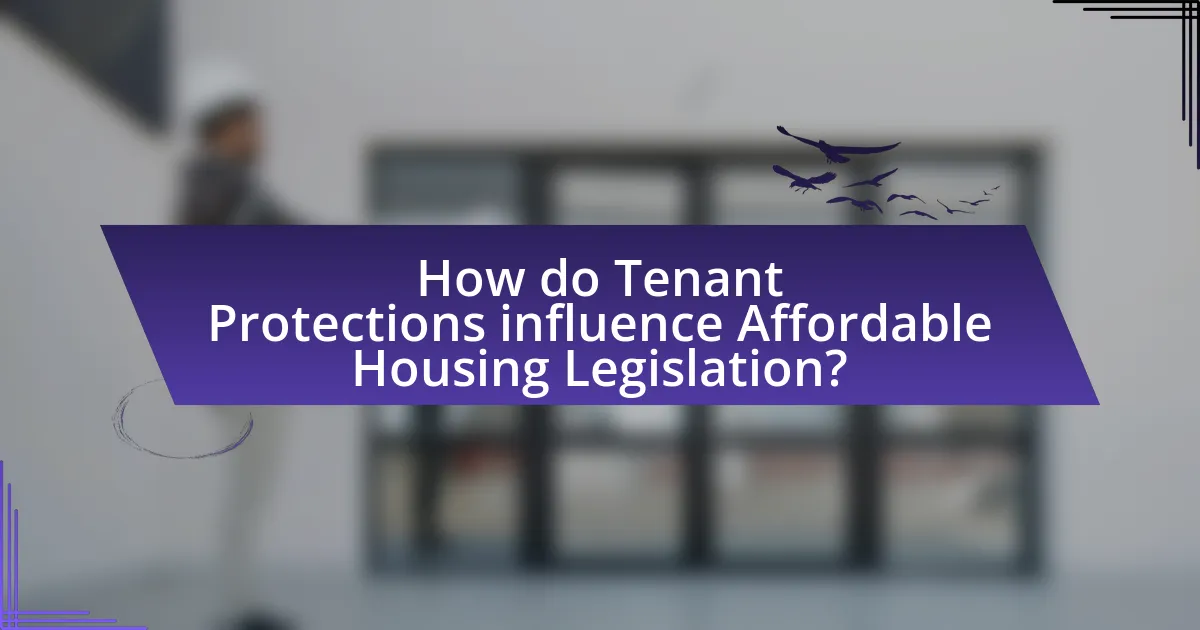
How do Tenant Protections influence Affordable Housing Legislation?
Tenant protections significantly influence affordable housing legislation by establishing legal frameworks that safeguard renters from eviction and discrimination, thereby promoting housing stability. These protections encourage lawmakers to prioritize affordable housing initiatives, as they recognize that secure housing is essential for community well-being and economic growth. For instance, jurisdictions with strong tenant protections often see increased investment in affordable housing projects, as developers are more likely to engage in markets where tenants are safeguarded against abrupt rent hikes and unjust evictions. Additionally, studies have shown that areas with robust tenant protections experience lower rates of homelessness, which further underscores the importance of integrating these protections into housing legislation to create sustainable and inclusive communities.
What role do tenant protections play in shaping housing policies?
Tenant protections play a crucial role in shaping housing policies by ensuring the rights and stability of renters, which directly influences the overall housing market dynamics. These protections, such as rent control, eviction regulations, and anti-discrimination laws, help to prevent displacement and promote affordable housing options. For instance, studies have shown that jurisdictions with strong tenant protections experience lower rates of homelessness and greater housing stability, which in turn encourages investment in affordable housing development. Furthermore, tenant protections can lead to more equitable housing policies by addressing systemic inequalities, thereby fostering a more inclusive community.
How do tenant protections affect the affordability of housing?
Tenant protections enhance the affordability of housing by limiting rent increases and providing stability for tenants. These regulations prevent landlords from imposing excessive rent hikes, which can lead to housing insecurity and displacement. For instance, a study by the National Low Income Housing Coalition found that areas with strong tenant protections experience lower rates of rent increases compared to those without such measures. This stability allows tenants to budget more effectively, contributing to overall affordability in the housing market.
What are the implications of tenant protections on landlords and developers?
Tenant protections significantly impact landlords and developers by imposing restrictions on rent increases, eviction processes, and property management practices. These regulations can lead to reduced profitability for landlords, as they may limit their ability to adjust rents in response to market conditions. For developers, tenant protections can complicate project financing and planning, as they may face increased scrutiny and regulatory hurdles that can delay or deter investment in new housing projects. Studies indicate that areas with strong tenant protections often experience a slowdown in new housing development, as developers weigh the risks associated with potential regulatory changes against the expected returns on investment.
How can tenant protections be effectively implemented?
Tenant protections can be effectively implemented through comprehensive legislation that establishes clear guidelines for rent control, eviction processes, and tenant rights. Such laws should include provisions for regular inspections of rental properties to ensure compliance with health and safety standards, as evidenced by successful models in cities like San Francisco, where strict regulations have led to improved living conditions. Additionally, creating accessible resources for tenants to understand their rights and providing legal assistance can empower them to advocate for themselves, as demonstrated by programs in New York City that have significantly reduced eviction rates.
What best practices exist for enforcing tenant protections?
Best practices for enforcing tenant protections include implementing clear legal frameworks, establishing accessible reporting mechanisms, and ensuring regular training for enforcement personnel. Clear legal frameworks provide tenants with defined rights and landlords with specific obligations, which can reduce disputes. Accessible reporting mechanisms, such as hotlines or online platforms, empower tenants to report violations easily, increasing accountability. Regular training for enforcement personnel ensures they are knowledgeable about tenant rights and can effectively address complaints. These practices are supported by studies indicating that jurisdictions with robust enforcement mechanisms see higher compliance rates among landlords and improved tenant satisfaction.
How can community organizations support tenant protection initiatives?
Community organizations can support tenant protection initiatives by advocating for stronger housing policies and providing resources to tenants. These organizations often engage in lobbying efforts to influence legislation that safeguards tenant rights, such as rent control measures and eviction protections. For instance, the National Low Income Housing Coalition reports that community organizations have successfully campaigned for policies that prevent unjust evictions, demonstrating their impact on legislative change. Additionally, they offer educational programs that inform tenants about their rights, helping to empower individuals to stand up against unfair practices. This multifaceted approach not only raises awareness but also mobilizes community action, reinforcing the importance of tenant protections in affordable housing legislation.
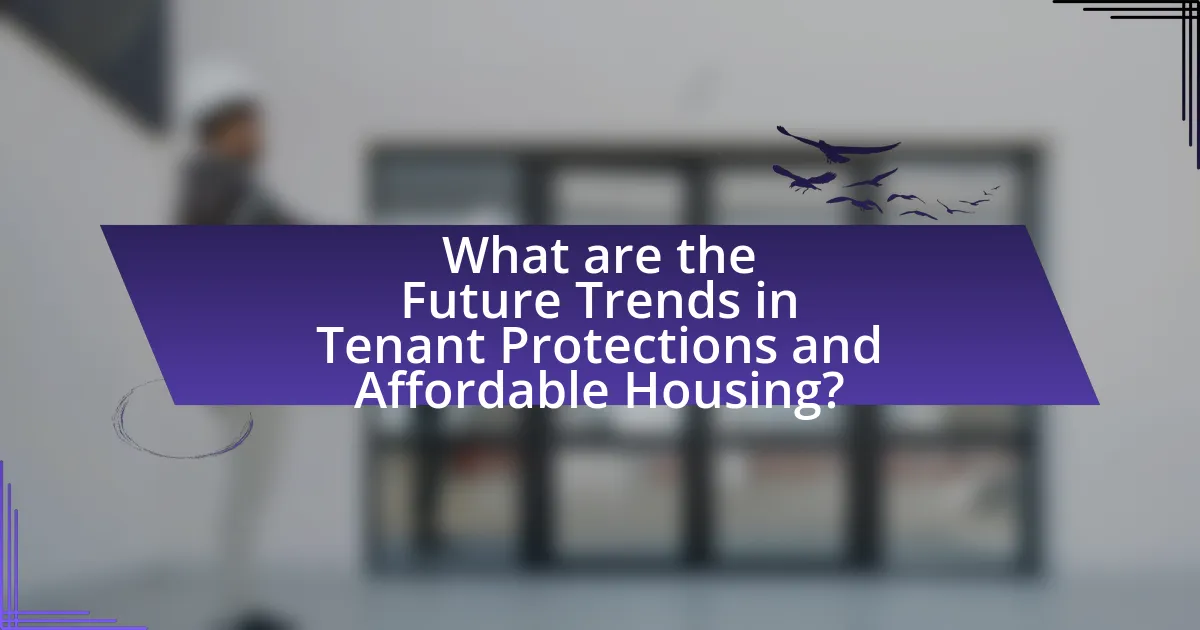
What are the Future Trends in Tenant Protections and Affordable Housing?
Future trends in tenant protections and affordable housing include increased legislative measures aimed at enhancing tenant rights, the implementation of rent control policies, and a focus on inclusive zoning practices. These trends are driven by rising housing costs and growing awareness of housing instability. For instance, cities like New York and California have enacted stronger rent stabilization laws to prevent displacement. Additionally, the Biden administration has proposed initiatives to allocate more federal funding for affordable housing development, aiming to address the housing crisis affecting low-income families. Studies indicate that areas with robust tenant protections see lower eviction rates, highlighting the effectiveness of such measures in promoting housing stability.
How are tenant protections evolving in response to housing crises?
Tenant protections are evolving through the implementation of stronger laws and policies aimed at preventing eviction and ensuring housing stability during housing crises. For instance, many jurisdictions have enacted rent control measures, expanded access to legal representation for tenants, and established emergency rental assistance programs in response to the COVID-19 pandemic, which highlighted the vulnerabilities of renters. According to a report by the National Low Income Housing Coalition, states like California and New York have introduced comprehensive tenant protection laws that limit rent increases and provide tenants with more rights, reflecting a growing recognition of the need for robust tenant protections in the face of ongoing housing affordability challenges.
What innovative approaches are being taken to enhance tenant protections?
Innovative approaches to enhance tenant protections include the implementation of rent control measures, the establishment of tenant advocacy organizations, and the introduction of legal frameworks that support eviction prevention. For instance, cities like New York and San Francisco have enacted rent stabilization laws that limit rent increases, thereby providing financial security to tenants. Additionally, organizations such as the National Low Income Housing Coalition advocate for policies that protect tenants’ rights and provide resources for legal assistance. Furthermore, some jurisdictions have adopted “just cause” eviction laws, which require landlords to provide a valid reason for evicting tenants, thereby reducing arbitrary evictions and promoting housing stability. These measures collectively aim to create a more equitable housing environment and safeguard tenants from exploitation.
How can technology support tenant protections in affordable housing?
Technology can support tenant protections in affordable housing by providing platforms for reporting issues, facilitating communication between tenants and landlords, and ensuring transparency in rental agreements. For instance, mobile applications enable tenants to document maintenance requests and track responses, which can be crucial in disputes. Additionally, online databases can store tenant rights information, making it accessible and promoting awareness. Research indicates that technology-driven solutions, such as tenant portals, can reduce eviction rates by 20% by improving communication and accountability between parties.
What practical steps can tenants take to advocate for their rights?
Tenants can advocate for their rights by organizing and participating in tenant unions or associations, which provide collective strength and resources. Engaging in local government meetings allows tenants to voice concerns and influence housing policies directly. Documenting issues such as maintenance problems or unfair treatment creates a record that can support claims for tenant rights. Additionally, tenants should familiarize themselves with local housing laws and regulations to understand their rights and responsibilities, enabling them to effectively challenge violations. Research indicates that organized tenant groups have successfully lobbied for stronger tenant protections, demonstrating the power of collective action in advocating for housing rights.
How can tenants educate themselves about their rights and protections?
Tenants can educate themselves about their rights and protections by accessing resources such as local housing authority websites, tenant advocacy organizations, and legal aid services. These resources provide comprehensive information on tenant rights, including laws regarding eviction, rent control, and habitability standards. For instance, the National Low Income Housing Coalition offers guides and fact sheets that outline tenant rights in various states, ensuring tenants are informed about their legal protections. Additionally, attending workshops or community meetings hosted by tenant organizations can further enhance their understanding of housing laws and available support.
What resources are available for tenants seeking assistance?
Tenants seeking assistance can access various resources, including local housing authorities, legal aid organizations, and tenant advocacy groups. Local housing authorities provide information on tenant rights and available housing programs, while legal aid organizations offer free or low-cost legal assistance for issues such as eviction and discrimination. Tenant advocacy groups work to educate tenants about their rights and may provide support in negotiations with landlords. According to the National Low Income Housing Coalition, these resources are crucial for ensuring that tenants understand their rights and can effectively navigate housing challenges.
